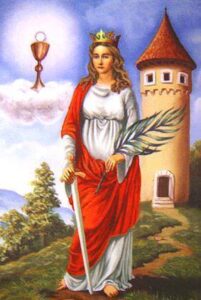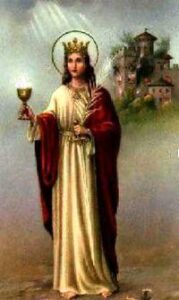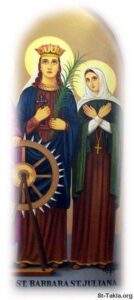St Barbara & St Juliana – Dec 4

Saint Barbara, known as the Great Martyress in Orthodox Churches, was a Christian saint and martyr, who lived in the 3rd century AD. The legend of St Barbara says that she was born in a wealthy aristocratic family, around 300 A.D. at Nicomedia in Bithynia, modern Isnik, Turkey. Lovely and intelligent Barbara was the daughter of a wealthy heathen and illustrious nobleman named Dioscoros, who lived in the Syrian city of Heliopolis. Her parents adored her for her beauty, intelligence and modesty. After the death of his wife, he devoted himself to his only daughter.
In his zeal to protect his young daughter, she was carefully guarded by her father who built a magnificent tower for her to live in, providing her with every material luxury, the best food, clothing, servants and teachers, but forbade her to have friends and even speak to anyone without his permission. Barbara was obedient to her father’s wishes and remained in the tower, without complaint, even during his frequent business trips. St. Barbara had a tender and fragrant soul. He felt that by keeping her secluded from the world, she was sure to grow up and be a pagan worshipper. Gradually, she realized that the idols could not have made the surrounding world. Soon the virgin began to ask herself questions about the First Cause and Creator of so harmonious and splendid a world. Once, gazing at the sky on a starry night, St. Barbara asked again: “Who are You, Who have created the mysterious sky?” All of a sudden, miraculously, the grace of God descended upon her, illuminating her heart and mind, and immediately she understood that it was the One and only God Who created everything. The desire to know the true God so consumed her soul that Barbara decided to devote all her life to this goal, and to spend her life in virginity

Once Dioscoros went for a long journey. Before leaving Dioscoros decided to build a bathhouse for Barbara next to her tower, with two windows. However, she instructed the workers to make an additional third window, which they did. One day, when the construction was nearly completed, Barbara stood by the pool facing the east she said, “In the name of the Father, the Son and the Holy Spirit,” and she miraculously drew the sign of the cross in the marble wall of the bathhouse with her finger. She then returned to her tower where she spent her time fasting and praying.
When Dioscorus finally arrived home he immediately noticed the additional (third) window in the bathhouse and became very angry. He entered the bathhouse, to inspect it further, and then noticed the large cross, carved on the marble wall. Barbara then proceeded to explain and confess her faith in the Holy Trinity. Influenced by the deacon Valentinus, who later became a bishop and martyr, she nevertheless secretly converted to Christianity. Upon hearing Barbara’s confession of faith, Dioscorus became furious! His plan of keeping his daughter in darkness had failed! Even though she had no ‘human’ teacher to bring her to the knowledge of God’s existence, Barbara’s mind, heart and soul were opened by the grace of God, to feel His presence. Secretly, she was able to meet with some Christians who told her about Christ and His teachings. Convinced of the Truth concerning Jesus, she became a Christian whose love for God inspired all who heard of her.

Dioscoros got angry with this and he wanted to kill her, however, Barbara escaped. Thereafter, Dioscoros wanted to give her in marriage to a gentile King. Barbara resisted the decision. He threatened Barbara and took her to Martianus, the chief of the town. Blinded by his fury, the Roman prefect, tortured her so that she denied Christ. Young Barbara was stripped and struck with whips and clubs until she was standing in a pool of her own blood. To increase the pain, the soldiers rubbed vinegar into her wounds. Through all this, Barbara stood firm in her faith and would not deny Christ. These efforts did not succeed, and she was barbarously tortured by different means. Afterwards, barely alive, she was thrown into prison, where she prayed: “O Lord, my God, do not leave me!” At midnight a bright light illuminated the prison and the voice of God was heard, saying: “Fear not, I am with you!” The Lord then healed Saint Barbara of all her wounds and became invisible.
The next day, Martianus was amazed to see that her wounds had healed and demanded her to deny Christ. Her refusal angered the prefect, who ordered her body to be hung on a stake and ripped with iron claws. The soldiers then burned her wounds with hot irons and beat her head with spiked clubs. Yet through it all, Barbara found consolation in prayer. “O God Eternal, after my death grant Thy bounty to everyone who will remember me and my suffering! May sudden illness and violent death never befall them!

Juliana witnessed Barbara’s tortures and wept bitterly over her inability to assist her. When Martianus saw this, he ordered that Juliana be brought forward and tortured in an effort to have her renounce her faith in Christ. Juliana refused and the horrible beatings resumed and continued for several hours while the young ladies stood praying and chanting hymns. Their refusal to renounce their faith only further frustrated Martianus and he ordered that the two girls be taken out of the city and killed! The bodies of the holy martyrs were buried by a pious Christian and became the source of numerous miracles and healings.
On his way back after the beheading of her daughter Barbara Dioscoros was charred by lightning and thunder. The faithful requests her intercession especially during lightening, thunder and storms. The date of martyrdom is given as 4 December A. D. 303. Sts Barbara and Juliana gained her crown of martyrdom on December 4, 306 and joined her true Father in Heaven. The Church celebrates the feast of Sts. Barbara and Juliana on 4 December.

0 Comments